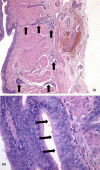An Unusual Presentation of Congenital Esophageal Stenosis Due to Tracheobronchial Remnants in a Newborn Prenatally Diagnosed with Duodenal Atresia
- PMID: 30039104
- PMCID: PMC6032603
- DOI: 10.5334/jbr-btr.881
An Unusual Presentation of Congenital Esophageal Stenosis Due to Tracheobronchial Remnants in a Newborn Prenatally Diagnosed with Duodenal Atresia
Abstract
Congenital esophageal stenosis due to tracheobronchial remnants is defined as an intrinsic stenosis of the esophagus caused by congenital architectural abnormalities of the esophageal wall. Although CES is present at birth, it remains asymptomatic till at the age of 4-10 months, when solid food is introduced. Here we present a case diagnosed in the neonatal period after urgent cesarean for an associated duodenal atresia complicated with perforation. There is a mutual association between duodenal atresia and congenital esophageal stenosis. When duodenal atresia is diagnosed, think of possible associated esophageal abnormalities, especially when duodenal atresia is complicated by gastric perforation prenatally.
Keywords: Constriction; Duodenal obstruction; Esophageal stenosis; Infant.
Figures



References
-
- Nihoul-Fekete C, De Backer A, Lortat-Jacob S, Pellerin D. Congenital esophageal stenosis: A review of 20 cases. Pediatr Surg Int. 1987;2:86–92. doi: 10.1007/BF00174179. - DOI
LinkOut - more resources
Full Text Sources
Other Literature Sources

